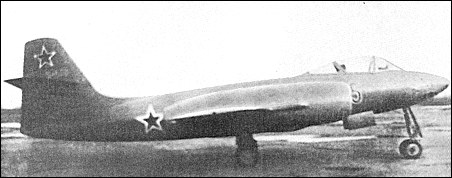 |
Alekseev I-2151948 |  |
| FIGHTER | Virtual Aircraft Museum / USSR / Russia / Alekseev |
 |
Semyon Alekseev's OKB encountered little difficulty in adapting the basic I-211 to take a Rolls-Royce Derwent centrifugal-flow engine in place of the axial-flow Lyulka TR-1. Owing to the centrally-mounted wing nacelles of the fighter, it proved possible to mount the larger diameter compressor of the British engine forward of the wing leading edge. Thus, apart from some structural redesign associated with and adjacent to the wing nacelles, the I-215, as the Derwent-engined aircraft was designated, was virtually identical with the I-211, and the first flight took place on 31 December 1947. The Derwent turbojets were rated at 1590kg each, rectifying the power inadequacy of the earlier fighter, but the wing centre section structure began to display fatigue cracking early in the test programme. Strengthening of the centre section dictated transfer of the twin-wheel main undercarriage units from wing wells to the fuselage, a second prototype, the I-215D (the suffix indicating dubler), being completed with a bicycle arrangement of larger-diameter paired wheels retracting into the fuselage fore and aft of the main fuel tanks, with small outriggers retracting into fairings beneath the engine nacelles. The I-215D was flown in the spring of 1948. Tests resulted in a recommendation by the Ministry of the Aviation Industry that series production be undertaken. A tandem two-seat night fighter version of the same basic design, the I-212 powered by two 2270kg Rolls- Royce Nene turbojets and having a larger wing, was being readied for flight testing at this time. However, Aleksandr Yakovlev's comment during a Kremlin meeting to the effect that the I-212 was "another copy of the Me 262" may be presumed to have influenced Yosif Stalin in his decision to disband the Alekseev OKB without flight testing the I-212, and, as a consequence, terminating the I-215.

|  All the World's Rotorcraft | |||||||||||||||||||||||||||||||||||||||||
 |

|